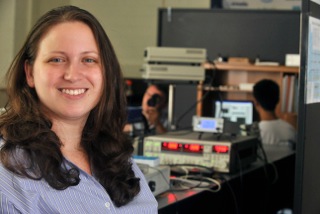Group Mission: To understand the unique properties that occur at material boundaries to enhance device performance

The benefits of this research are twofold: the innovative combination of x-ray absorption spectroscopy (XAS) and nonlinear optics measuring techniques can be readily applied to other material systems, and the data generated in this study may illuminate not only the factors that contribute to stronger coupling at interfaces, but also better engineering of the electric and magnetic properties of other complex oxides. The results will help to uncover the role of interfacial mechanisms on the strength of ME coupling, an outcome that could be potentially transformative to advance in interface research and technology. Due to its exciting potential for application, this research is ideal for educating younger students about the opportunities in condensed matter physics.
Dr. Holcomb has over a decade of previous experience in characterizing films exploiting two techniques that are ideal for the study of interfacial effects. Second harmonic generation (SHG), sensitive to both electric and magnetic fields at interfaces, is a perfect tool to monitor magnetoelectric behavior (Tokura, 2007). As electromagnetic radiation propagates through matter, the electric field exerts forces on the sample’s internal charge distribution. The resulting redistribution of charge generates an additional field component that leads to the generation of light of twice the frequency of the incident light. Analysis of the intensities of this doubled light with light polarization rotation, sample rotation, temperature and applied field, provides information on carrier and interfacial field dynamics (McGilp et. al., 2009). Photoemission electron microscopy is a powerful technique that takes advantage of the sensitivity of x-ray absorption spectroscopy to excited states in materials. The dichroism effect observed in magnetic and ferroelectric materials is utilized in PEEM to image the domains. The element specificity allows the imaging of multiple material layers and magnetism at interfaces (Ohldag et. al., 2009), allowing the study of coupling in heterostructures. Dr. Holcomb and others have used both of these techniques to study magnetoelectrics and other complicated heterostructure systems. These complementary approaches of nonlinear optics and XAS allow unique studies of material coupling.